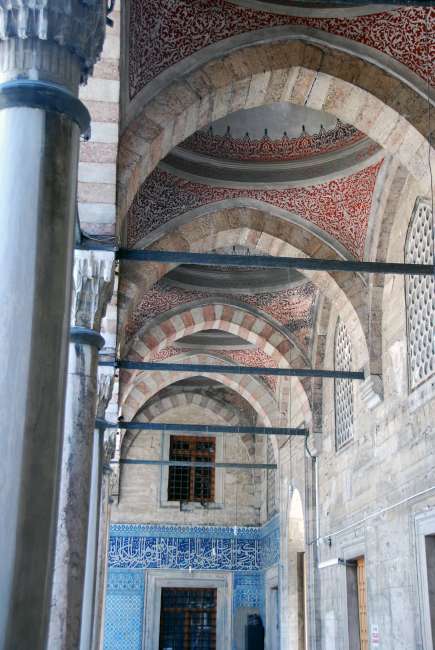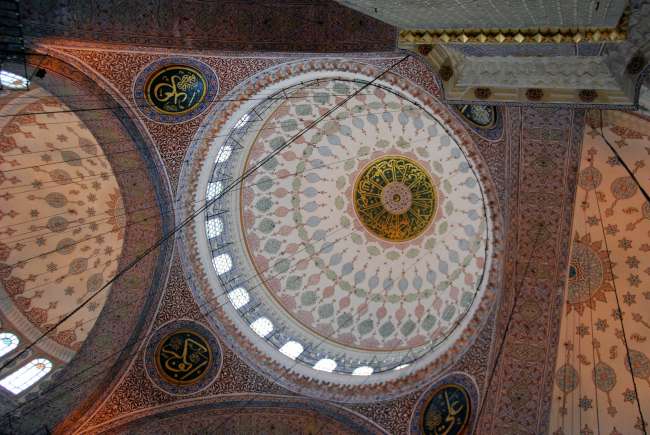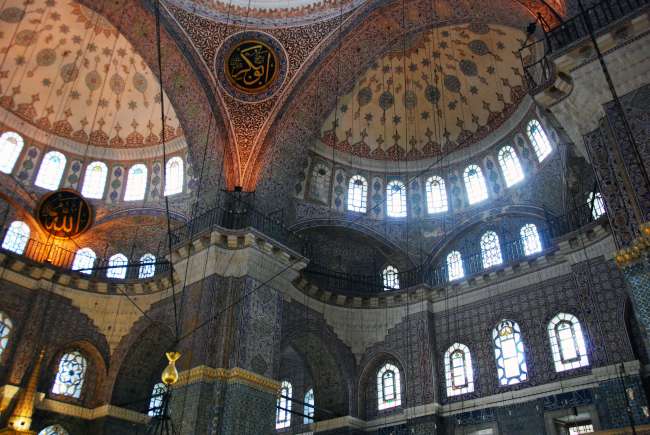Turkey: Istanbul
- Description
- View Photographs
Yeni Mosque
Located in the heart of the old Ottoman commercial district, this large Ottoman mosque measures 41 meters on each side, has a main dome of 17.5 meters in diameter and 36 meters high. It is located nearest to the L-shaped Egyptian, or Spice, Bazaar. Read more ...
Wednesday, November 16, 2011Yeni Mosque and the Age of Anarchy
One of the most popular tourist sites in Istanbul, Turkey today is the Yeni Mosque. It is strategically placed in the heart of the old city, next to the L-shaped Egyptian bazaar (otherwise known as the Spice Bazaar) and overlooking the Bosphorus. It features six domes with two towering minarets. Its main dome is 17.5 meters in diameter and is 36 meters high. The interior of the mosque is exquisitely decorated with Iznik tiles and with marble columns near the minbar of the mosque.
The Yeni Mosque was built between 1597 and 1665, the longest stretch of time taken to build any mosque in the Ottoman Empire. This period coincided with the most tumultuous period in the empire that resulted in total anarchy throughout the land and the passing of seven Sultans. The very choice of location and architectural style is a reflection of the decadence, corruption and chaos that the empire endured throughout the beginning of the 17th century. In this article, the conditions of the Ottoman Empire from when the mosque was commissioned to when the mosque was finally built are examined.
Mehmet III reigned from 1595 to 1603. He was largely an ineffectual ruler and did not display strong desire to govern. This allowed his mother, Safiye Sultana, to have great influence over him. There were only two significant events that happened in his reign. First, in a bid to outflank the Spanish, the English under Queen Elizabeth I, were keen to establish good relations with the Ottoman Empire. Her majesty`s flagship, the Hector, sailed to the Bosphorus and was open to visitors to board the ship and examine it. The Venetians were outraged by this as it may open the Ottoman eyes to “things they do not know.” No such eye openings occurred, and Mehmet III viewed the ship with very little curiosity or interest. Had this occurred a mere decade earlier, before the death of the famous Ottoman admiral Uluj Ali, this opportunity to modernize the Ottoman navy would not have been missed.
The other significant event was the commissioning of the Yeni Mosque under the leadership of Safiye Sultana. This was the first imperial mosque not to be commissioned by the Sultan himself. The construction of the mosque was riddled with political rivalries of the time. It was in a predominantly poor area and the local inhabitants were given some compensation and forced to relocate. The vast expenditures of the building effort also conflicted with the Janissaries, who greedily felt entitled to the money through increased salaries and benefits. Nevertheless, the building project continued and was only stopped in 1603 when Mehmet III was no longer emperor.
A series of three emperors with short lived reigns then followed. The first, Sultan Ahmet I, seemed to be a capable leader. He is credited for commissioning the construction of the Sultanahmet mosque, otherwise known as the Blue Mosque, overlooking the Hagia Sophia. Today, it is one of the most popular attractions in Istanbul. He opened the empire with increased trade agreements, known as Capitulations, which allowed the English and Dutch to have trade and navigation advantages in the Ottoman Empire. These agreements, however, later proved disastrous for the Ottoman Empire. During his reign, extortion and malpractice at the public sector went unchecked, further bringing the empire closer to financial ruin.
Next, came the reign of Mustafa I. Although he was mentally unstable, the Janissaries preferred him since they thought he would be easy to control. The Janissaries bored with the lack of war and its financial rewards, decided to attack peasants and demand high taxes. This, again, went unchecked throughout the land. After much trouble, Mustafa I was replaced by Osman II. He took the throne at the age of 14. Again, the Janissaries were not worried about him due to his young age. He was well educated and spoke several languages. He quickly recognized that the Janissaries have now become a major liability to the empire and had to reform. He secretly conspired to eliminate the Janissaries and replace them with a new military discipline, one that matched current armies of the 17th century. His plan was to gather troops from the Asian provinces under the guise of him going to travel to perform his religious pilgrimage to Mecca. The Janissaries found out about his plan, revolted against him, killed him, and reinstated the mentally unstable Mustafa I. This was the first incident that the strong arm of the Sultan, the Janissaries, turned against their own leader and killed him; but it would not be the last.
Murat IV, Osman II`s brother, ruled from 1623-1640. He was 11 when he took the throne and the empire was effectively governed by his relatives. At this time, the empire was in complete anarchy. The Janissaries and irregular troops were looting the land, demanding extraordinary taxes from poor peasants. Financial corruption was spread through every level of the Ottoman social fabric. At age of 20 (1632), he began to take matters into his own hands and started to rule the empire himself. He initially ruled justly and wisely. When the Janissaries demanded that his friend and Grand Vizier be executed and replaced by one of his rivals, he became bitter and vengeful. Unable to stop them and aware of what happened to his brother, Osman II, he let them execute the Grand Vizier. He was very tactful and quick in his revenge. He started by beheading the replacement Grand Vizier and throwing his head far into the air in front of a congregation of Janissaries. The quickness and suddenness of his action instilled fear in them. During his last 7 years of rule, it was said that he killed over 40,000 people through strangulation and decapitation. He prohibited the use of alcohol, tobacco, and coffee. Although his rule was especially brutal, it was what the empire needed in order to reestablish order. The order that his brutal rule brought, enabled the army once again to be an effective disciplined fighting force. He recaptured large areas, including Baghdad, from the Persian Empire that had been lost during the years of Ottoman anarchy. He also instituted economic reforms that set the Empire on the correct path. He traded artisans with the Mogul empire, including two Indian pupils that would later build the Taj Mahal. On his death bed, he ordered his brother, Ibrahim I who was mentally unstable, to be strangled. This would have meant the end of the Ottoman line. His orders were not carried out in fear of throwing the empire to chaos. However, as history will show, the failure to obey Murat IV`s last order nearly brought the empire to an end.
Ibrahim I, who was mentally unstable, ruled from 1640 to 1648. He led haphazardly declaring wars at random, executing hundreds of people in one order at random as well. He even offered one of his harem women the title of Governor of Damascus because he was so pleased with her size (it was said that she weighed over 330 pounds). He was eventually strangled under the orders of his Grand Vizier with the support of the Janissaries. This would be the second sultan to be killed by the Janissaries.
The last ruler in this tumultuous time was Mehmet IV, who ruled from 1648 to 1687. He was at age 7 when he took the throne. His executive powers were given to the Grand Vizier Koprulu Mehmet, then later by his son Koprulu Ahmet. Mehmet IV was known for his lust of hunting. He would spend much of his time outdoors conducting his favorite sport of hunting. Animals used in his sport consisted mainly of pedigree hounds and falcons brought mainly from Russia. Holding the empire together, both Koprulu Mehmet and his son governed the empire well.
Such a reign of instability had cost the empire valuable time as it fell behind in modernizing its economy and army. Despite their inferior weaponry and tactics compared to the Europeans at that time, they were still able to make advances into Eastern Europe, the Mediterranean, and the Caucasus. While the Ottoman Empire went through tumultuous times of instability and internal strife, the European nations were kept busy by their own internal divisions which resulted in the Thirty Years` War. Although this saved the Ottoman Empire from direct attack during its most fragile time, it helped the European nations gain warfare experience and advance militarily in terms of organization, training, equipment, tactics, and authoritative leadership. The Habsburg army had better guns, employed muskets which the Ottomans have never seen, and employed new battle strategies to incorporate the new weaponry. Through poor politics of Ahmet I, who granted Capitulation treaties to France`s rivals, the Ottoman has also lost its strongest European ally of France. In 1664, a direct confrontation of the Ottoman army with the Habsburg army demonstrated this by resulting in the first defeat of the Ottomans in Eastern Europe. Most of the advanced weaponry that the Habsburgs used in battle was lent by the French, which at the time was the most technologically advanced European nation. Not all was lost for the Ottomans, as Kopulu Ahmet was able to negotiate a settlement favorable for the Ottomans. The Ottomans then went on the invade Crete, which had been besieged for 25 years and was under Venetian control. The Ottomans did not loot or pillage the capital, Candia, and the inhabitants regarded the Ottomans as liberators from the Catholic oppressors.
Korprulu Ahmet did set the empire back on a path of recovery. He expanded the territories of the empire by securing the European borders, controlling the Aegean Sea, and conquering Ukraine. He instituted social and justice reforms to curb corruption. The economy under his leadership started to recover. All his gains would be reversed when his successor, not heeding to the fact the army was using inferior weaponry and tactics, foolishly decided to attack Vienna in 1683. Although the attack`s failure was a sufficient disaster. The aftermath of the attack, which resulted in a 16 year war proved to be a catastrophe for the Ottoman Empire. It lost vast territories in Eastern Europe. Venice, which previously would not dare attack the Ottomans, declared war on them and captured vital waterways. Even the Russians occupied Ukraine from Ottomans. So bad was the catastrophe, that Mehmet IV was dethroned in 1687 and imprisoned in Edirne until his death in 1693.
The Yeni Mosque was finally completed and inaugurated in 1665 under the leadership of Turhan, Mehmet IV`s mother. The mosque contains the graves of Turhan, her son Mehmet IV as well as five other Sultans that came later to preside over the Ottoman Empire. The word “Yeni” in Turkish means “new”. The construction of the Yeni Mosque truly marked a new age in Ottoman history. An age where the Ottoman has reached its greatest territorial extent; but also an age where decadence and corruption engulfed the empire so much that it set it on a new path of unstoppable decline that became all too obvious after the events of 1683.
References
Keywords: Turkey, Istanbul, Ottoman, Habsburg
Related Articles
Yeni Mosque Photos




























|

